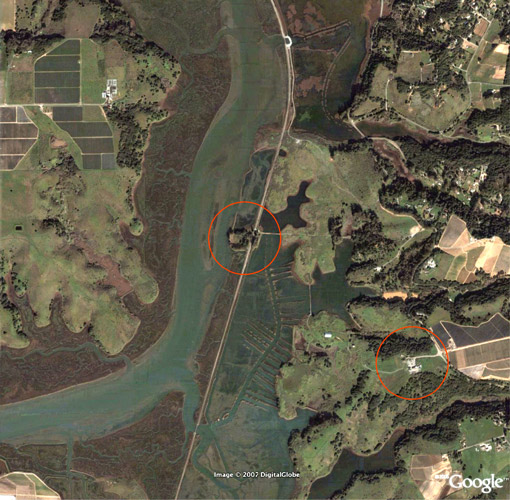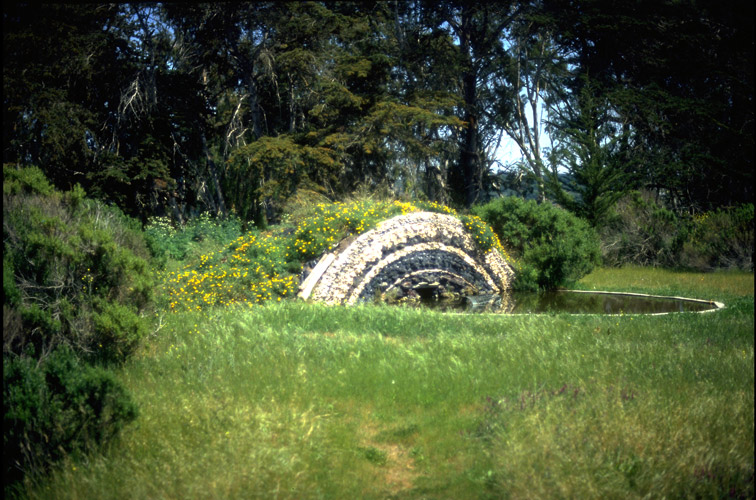Isla
de Umunnum (Island of the Hummingbirds)
A land
reclamation project creating a native habitat and sanctuary for
hummingbirds, Elkhorn
Slough National Estuarine Research Reserve, Moss Landing, CA 1986-89.
Left: Trellis element, 18
ft. (5.5 m) high, steel, copper, wood, native plants.
Center: aerial image of Elkhorn Slough, central circle marks Isla
de Umunnum site, the lower right circle marks the Elkhorn Slough
Natural Esturine Research Reserve Visitor's Center
Topo map of Elkhorn Slough,
showing the site's relationship to Monterey Bay;
Driving Map,
Directions and Address of the Reserve
Right: Mound/Pond
Element: 6 ft. high, concrete, water, stone, native plants.
|
Isla
de Umunnum (Island of the Hummingbirds) is
an environmental art work, designed and built by Heather
McGill and John
Roloff for the California Arts Commission’s Art in
Public Buildings Program.
The
project is a part of a large, protected wildlife habitat,
the Elkhorn Slough National Estuarine Research Reserve.
The Reserve is sited in the estuary and coastal hills along
Elkhorn
Slough, an inlet from the Pacific Ocean at Monterey Bay
in central California. The site of the artwork is a 3-acre,
island-like tract of land surrounded by the slough’s
waters and marshlands. The project is accessible to the
mainland by a maintenance road and trail.
The
focus of the project is to create a special habitat and shrine
for indigenous and migrating hummingbirds. Inspired by hummingbird
life and mythology, the elements of the project are both
functional and symbolic. One of the two functional structures,
Trellis element, is a dome-shaped trellis for native honeysuckle
vines; a hummingbird food-source surrounded by a formal array
of
other
food-source plantings such as native flowering manzanita,
fuchsia and monkey flower.
|
The
second major structure, Mound/Pond element, provides additional
hummingbird food sources and is the only source of fresh
water on the island. Two bench elements
and an extensive path system paved with white oyster shells
allow for visual interaction with feeding hummingbirds
and exploration of the island. The
focus on the symbolic value of the hummingbird pays homage
to its very special place in the mythology of many cultures
of the Western Hemisphere, its unique quality as a species
and the distinctive richness of Elkhorn Slough.
The
planning and construction of this project was accomplished
through the help of many individuals including: Mark Silberstein,
Director and Staff Biologist of Elkhorn
Slough National Estuarine Research Reserve, rangers from The California Department
of Fish and Game, the California Conservation Corps, prisoner
fire crews from Solidad Prison and the Santa Cruz County
Native Plant Society.
Additional
information on this work is available from Visitors Center
at Elkhorn Slough, in Fragile Ecologies: Contemporary
Artists’ Interpretations and Solutions by Barbara
C. Matilsky, Rizzoli, 1992 and as Isla
de Umunnum, on
the Center for Land Use Interpretation web site.
|
Roloff
Home; CLUI
Land+Art
|


